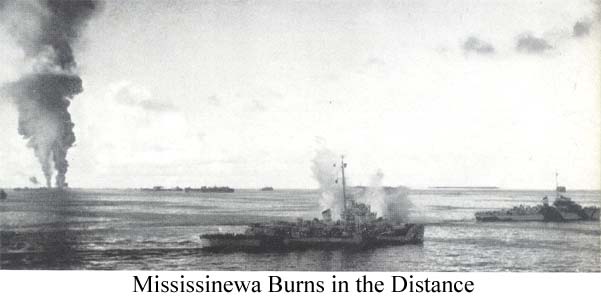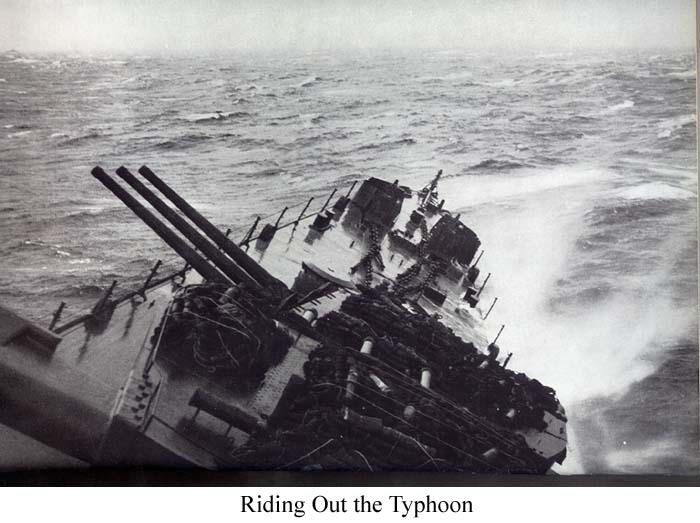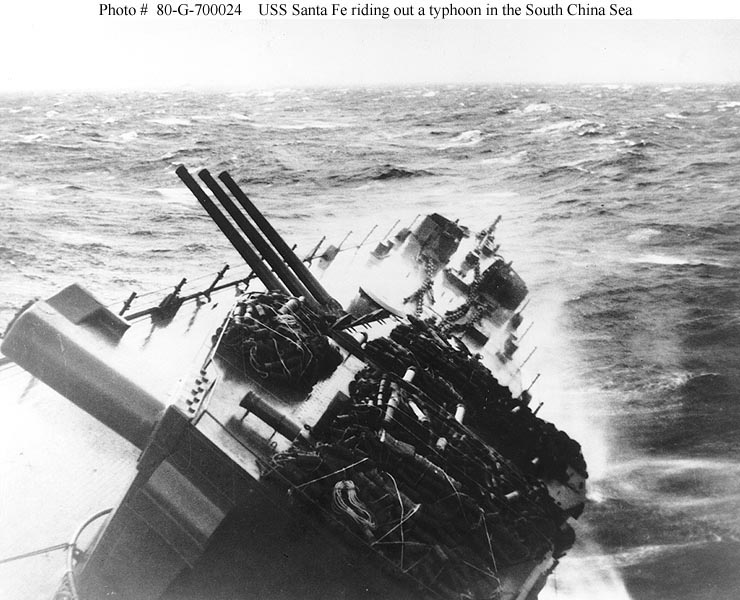|
Reports of the approaching Japanese fleets trickled in from U. S. submarines operating off Borneo Palawan and Manila on the 23rd of October. The entire combatant strength of the Japanese Navy was converging on Leyte Gulf. On shore, MacArthur's men pulled in their lines, consolidated their positions, and awaited the outcome of the battle in which they were the pawns. There ensued the three almost simultaneous naval actions (the Battle of Surigao Strait, the Battle off Samar, the Battle off Cape Engano) which have been collectively dubbed the "Battle for Leyte Gulf," as the myriad ships of America's Third and Seventh Fleets were welded together to meet the oncoming foe. Halsey was ordered west to strike at the enemy, Task Group 38.3 proceeding to a position cast of the Polillo Islands. At 0750 on 24 October, some two hours after the SANTA FE's carriers had sent squadrons winging to the southwest to locate the Japanese, a large group of hostile aircraft were reported closing from the west. Few of them got the U.S. patrols vectored to intercept them, but those which did gave Captain Wright's gunners a strenuous workout. One absorbed SANTA FE gunfire, missed the nearby destroyer HEALY with a bomb, and crashed in a blossom. of flame on the horizon. At 0938, as the U.S. Navy planes were returning to their carriers, a single Japanese which had followed them back undetected zoomed out of the overcast, loosed one of his bombs, and scored a bullís eye on the flight deck of carrier PRINCETON. At 1015 the SANTA FE's anti-aircraft guns crippled another Japanese plane, whereupon a Navy fighter quickly finished the job. Noon brought another bevy of "bandits" (an unidentified aircraft is a "bogey," while one established as enemy is a "bandit"). SANTA FE found herself, at 1350, in the uncomfortable position of firing on four planes simultaneously. Other Japanese planes dived on the formation twice in the following hour, but with each pass their bombs missed. Electrifying news came through at 1637: search planes reporting contact with the Empire's Northern Force (1 large carrier, 3 light carriers, 2 battleships with flight decks, 5 cruisers, 6 destroyers). Task Group 38.3 shed the PRINCETON, which earlier had been crossed off the roster when her magazines let go, then mustered with other task groups and surged north to the attack. That night., farther down the Philippine Archipelago, Rear Admiral Jesse B. Oldendorf ranged his old battleships across the mouth of Leyte Gulf, remembered to cross his "Tís", and crushed the huge Japanese Southern Force as it glided in column up Surigao Strait. At dawn on the 25th off Cape Engano on Luzon's northeastern tip, Admiral Halsey's planes fell upon the Northern Force, and sank all four carriers. Off Samar, the Central Force jumped the lightly-armed U. S. escort carriers, but it too was hacked apart, as it attempted to retire to San Bernadino Strait on the afternoon of the 25th.
Enlisting with a cruiser-destroyer striking group (others: MOBILE, WICHITA, NEW ORLEANS, and 12 destroyers), the SANTA FE took a northerly course at 1415 on 25 October. To this group went the task of mopping up the sea full of maimed remnants left floundering near Cape Engano. At 1605 the cruisers came across their first target, the Japanese light carrier OKUDA dead in the water but otherwise intact. Captain Wright's main battery drew a bead on the stricken flat-top at a range of 14,500 yards, and opened up at 1631. Medium caliber weapons cracked back from the carrier but failed to connect. All the cruisers ceased fire at 1639, with their target burning freely and listing heavily to port. At 1655 the CHIYODA rolled over on her side and headed for the bottom of the Philippine Sea. From there the scavenger flock continued searching northward. Three enemy vessels were spotted escaping at sunset, with only one of them remaining to face the SANTA FE's force. Fighting a desperate rear guard action, the Nipponese warship (believed to be a light cruiser but never positively identified) held her antagonists at bay until their combined gunfire cut her to pieces. One by one the Japanese ship's guns stopped returning salvoes, and at 2056 she dropped out of the engagement altogether -- straight down. Other ships were reported farther northward but the fuel situation would not allow further chase. At 3250 the cruiser-destroyer detachment back-tracked to the south, rendezvousing with the carriers about 0900 on 26 October. Back among the carriers of Task Group 38.3, USS SANTA FE stood by with guns primed as minor strikes were launched against crippled stragglers in the Visayan Sea 27 October. U.S. re-entry into the Philippines had survived the major Japanese surface fleet attack. In the "Battle for Leyte Gulf" the U.S. Navy wrote a fiery finis to the Nipponese Navy as an effective fighting unit, and also garroted the embryonic Sho No. 1. Reaching Ulithi Lagoon 30 October 1944, Cruiser Division 13 underwent a change in command. Rear Admiral Morton L. Deyo stepped in as its commander on 2 November, relieving Rear Admiral DuBose. Cruiser SANTA FE also piped a new Commanding Officer aboard on the 1st of November, when Captain Harold C. Fitz, USN replaced Captain Wright. While it was heading for Manus in the Admiralties late on 1 November, Task Group 18.3 received orders diverting it to the Philippines to cope with heavy enemy surface units reportedly bearing down on Leyte. Enroute to the Philippines, the task group on 3 November was accosted by an enemy pig-boat which sent a torpedo into the RENO. Minus that cruiser, which returned to Leyte for repairs, the task group continued westward, and found the report of a surface attack against Leyte to be a false alarm. But the steady pounding which Luzon-based Japanese planes were dishing out to U. S. troops on Leyte was the real thing. Task Group 38.3 launched strong attacks against the Manila area on 5 November, and had its first experience that afternoon with the newly organized Special Attack Corps. Macabre, effective, supremely practical under the circumstances (few planes, fewer pilots), sparked by a powerful propaganda campaign, these suicidal bleeding tactics constituted the last play of a nation facing suicide. SANTA FE was introduced to the kamikazes on the afternoon of the 5th when three of them broke through the protective combat air patrol. One suicider crashed into the carrier LEXINGTON, another near the TICONDEROGA, while the third was dropped by anti-aircraft fire. Two other raids later in the afternoon were beaten off by fighters. Manila was hit again on 6 November, after which the force retired eastward to fuel. On 10 November the carriers were again off the Philippines, this time to strike enemy shipping in the Visayan area. Searchers launched 11 November located an enemy convoy in the Cametes Sea, which was annihilated after one strike from three U. S. carrier task groups. Sustained strikes were aimed at the Manila area 13-14 November, whereupon the SANTA FE wended her way to Ulithi with the carriers, arriving 17 November 1944. Midget submarines crept into Ulithi Lagoon on 20 November, one of which torpedoed the tanker MISSISSINEWA. One of the SANTA FEís Kingfishers, flying patrol at the time, landed near the blazing vessel and hauled several survivors clear before rescue boats could arrive on the scene. On 22 November the SANTA FE's task group stood out of Ulithi for more Philippine air strikes.
As the U. S. planes hit enemy shipping on Luzon's west coast 25 November, Japanese planes hit the SANTA FE's force. One suicider dove through the anti-aircraft screen at 1254 and crashed on the carrier ESSEX; a second was splashed by the SANTA FE. Heavier attacks were made on adjacent task groups, resulting in two U.S. ships taking kamikaze crash-dives. East of the Philippines that task group operated in a supporting position until 2 December 1944, when it returned to Ulithi.
Task Group 38.3 left Ulithi 10 December, commissioned to deny the Japanese use of their airfields while the Mindoro landings were in progress. December 14-16 saw heavy Navy raids on the entire Mindoro area. On the 17th fueling-at-sea to the east was interrupted when the bottom dropped out of the barometer. Cruiser SANTA FE bucked a 55-knot gale as she drove west through frothy head seas. Cyclonic fury whipped the Philippine Sea into seething turbulence and the task force separated in the night, each unit attempting to find the easiest riding course. Wind and water pounded at the SANTA FE, lifted her like a matchstick, and at one point sent her rolling 50 degrees to starboard.
Some 35 miles north of the SANTA FE, the storm's nucleus passed about 1400 on 18 December. Three destroyers had capsized in the clutch of Nature, and several members of the task force were sent limping back to Ulithi badly damaged. Ships which remained in the operational area searched for the survivors of the sunken destroyers, and also tried an air approach on Luzon on the night of 20 December but cancelled it when weather conditions proved too unfavorable. Another sweep was made for lost destroyer men before Task. Group 38.3 put into Ulithi on 24 December 1944. |





